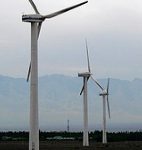Thanks to the Chinese government’s recent fiscal stimulus package, China’s environmental and renewable energy sectors are poised for another year of strong growth despite the global economic downturn. However, private investors seeking to cash in on commercial opportunities should remain cautious: the country’s green industries still face a variety of challenges, and investors will first have to carefully navigate these to be successful.
So far, China’s green sector has withstood the current financial crisis and continues to enjoy a steady stream of capital inflow. This resilience is in part thanks to the central government’s most recent 4 trillion yuan (US$586 billion) stimulus package, which includes 350 billion yuan (US$51 billion) earmarked for environmental projects such as waste-water treatment plants and renewable energy facilities.
The benefits of this government-backed spending spree are quickly becoming apparent, with a surge in government-solicited bids for environmental projects across the country. These developments, of course, have led to new investor optimism. CleanTech Group, a private consultancy, reported that investors at this month’s conference in Shanghai see no slowdown in the Chinese clean technology industry. Similarly, the National Development Reform Commission recently reported that for the fourth quarter alone, investments in the country’s rural water resources and energy facilities, such as biogas, topped over 22 billion yuan (US$3 billion).
While this is good news for China’s green industries and the country’s quest to improve its environmental performance, investors seeking to make a quick profit from this growth must beware. China’s green sector, while it has improved significantly, remains an extremely competitive industry that is fraught with obstacles, allowing only the strongest companies to survive.
One key challenge is costs. While labour is no doubt cheaper in China, the country’s business climate is a race to the bottom, in which firms must constantly find ways to make lower priced products. However, Chinese manufacturing costs have recently surged, thanks in part to the rising price of some raw materials which have to be imported. In August 2008, the Chinese Producer Pricing Index grew by a record 10.1%, compared with the same period in 2007. These price increases are being felt in particular by domestic photovoltaic panel manufacturers, which can pay up to 100% more than their foreign competitors for the silicon used to build the wafers. This added cost can negate the competitive advantage provided by low labour costs.
Another challenge is the lack of human capital. While China has no shortage of educated workers, the brightest minds are entering into more lucrative industries, such as finance and information technology. These sectors are attractive as they can generate quick profits, as opposed to environmental companies whose revenue streams can take years to develop. The end result is a lower quality of human resources in many domestic green companies, a situation which can only be ameliorated by offering more competitive salaries.
Perhaps the most important challenge is that the market for environmental goods and services remains fragmented because of the undeveloped regulatory infrastructure. The country has undoubtedly strengthened its environmental laws, such as increasing the powers of its environmental agencies, but powers of enforcement remain weak.
For example, an investigation by the Ministry of Environmental Protection into the country’s 500 largest enterprises found that more than 40% had failed to adopt the necessary environmental abatement measures they promised in their environmental impact reports. Also, the ministry found that the number of reported incidents of serious pollution is increasing by an annual rate of 30%, with one event now being reported every two days.
Certainly, there will be an emergence of Chinese green firms that will not only help the country improve its environment, but also earn substantial profits. However, these companies will require both superior technical capabilities and the necessary business skills. Wise investors will need to do their homework to identify such enterprises.
Ray Cheung is a senior associate at the World Resources Institute’s Markets and Enterprise Program. The views expressed are his own and excerpted from the book “Sustainable Investing: The Art of Long-term Performance,” published by Earthscan and edited by Cary Krosinsky and Nick Robins.
Homepage photo by XiaoMaoWang




